A Winter’s Tale, published on October 11, 2005, is the official English-language translation of an independent freeware Japanese visual novel called Aru Fuyu no Monogatari, which was first released in Japan in 2002 (the final version, which was the object of translation, was released on October 3, 2003). The English-language translation, completed by AstCd2, was contributed to the inaugural al|together visual novel translation festival in 2005. It remains free to play and download. I am in the midst of a project to review nearly all of the al|together visual novel translations from the three festivals in 2005, 2006, 2008. Below, I review A Winter’s Tale as the 17th entry in this long-running series.

A Winter’s Tale is the story of two childhood friends, Jun Suzuhara (the view-point character) and Kaede Sakurai, during the December winter break in their penultimate year of high school. The lazy and somewhat sluggish Jun and the simultaneously forward and reserved Kaede had developed a rapport over their ten years of friendship. However, friendships between a boy and girl can change, and we catch Jun and Kaede, through their pleasant banter, working to sort their feelings as the winter winds of impending change blow. While it is a short visual novel in the grand scheme of things, it is long by al|together standards, likely taking most readers somewhere between one and two hours to read.
A Winter’s Tale Details
Below, I list details about and links about A Winter’s Tale, when it was released, and who was behind the original Japanese version and the subsequent translation.
English version
| Title | A Winter’s Tale |
| Translator | AstCd2 |
| Release Date | October 11, 2005 |
| Engine | ONScripter-EN |
| Official Website | altogether 2005 |
| Visual Novel Database | VNDB link |
Japanese original
| Title | Aru Fuyu no Monogatari |
| Developer | Kenji Endou (circle) |
| Original release date | November 15, 2002 (see research) |
| Final version | October 3, 2003 |
| Engine | NScripter |
| Archived website | Link (as of original release) |
Running and downloading A Winter’s Tale
A Winter’s Tale is available as a torrent download from the al|together 2005 website for Windows, Linux, and MacOS. It is available as a direct download for Windows from Kaisernet. Moreover, all versions are available for download from a curated MEGA collection. For those who are able, I recommend persisting with the official torrent to help ensure that it continues to be available from the most readily-available source. However, Kaisernet provides a very easy direct download option.
- Official torrent
- Kaisernet (Windows direct)
- MEGA collection
Because I run Linux, I played A Winter’s Tale natively on Linux. The bundled ONScripter-EN executable for A Winter’s Tale did not work on my system – which is the case for most of the al|together ONScripter games on Linux. However, it ran with no issue when I replaced the bundled version of ONSCripter-EN with the most up-to-date version, a very easy process that I described in two articles (see running ONScripter-EN from installation or extracting the executable in game directory). Moreover, Linux, MacOS, and BSD users can extract the content of the Windows version and run the most up-to-date version of ONScripter-EN in the extracted directory, an easy process that I described in a step-by-step guide. The Windows version should install and run on most Windows systems. While I did not have trouble with the Windows version in a brief test under WINE, there are recent reports from some players that the pre-packaged Windows version does not run well on modern systems. If you have issues, replace the A Winters Tale executable in the Windows folder for the game with the most up-to-date version of ONScripter-EN, available here (the process is nearly identical to what I demonstrated for Linux, just with the Windows build of ONScripter-EN instead of the Linux build).
General overview of A Winter’s Tale
The original Japanese website for Aru Fuyu no Monogatari described it as a “pure love sound novel” and gave the following one sentence summary (courtesy of Google Translate):
[T]he story of the winter vacation of the main character and his childhood friend.
Accurate enough I suppose. The al|together 2005 page focuses more on the merits of the project than its particulars. Thus, I will provide a sort of general overview without spoiling the story for prospective readers.
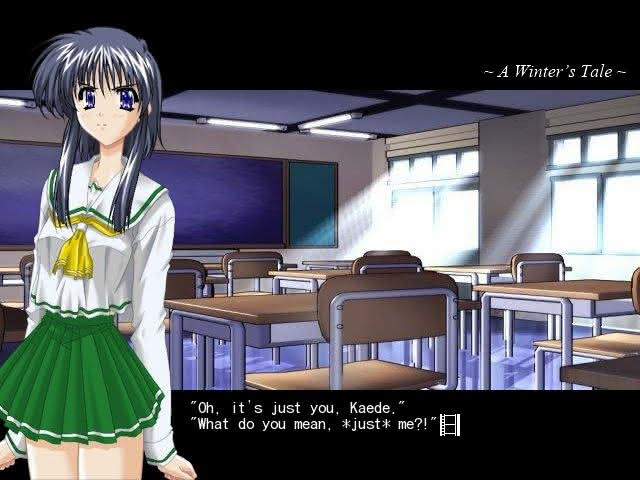
The story of A Winter’s Tale is seen from the perspective of Jun Suzuhara, an 11th-grade high school student. Jun and Kaede Sakurai, his childhood friend and classmate, are the only two significant characters, although Jun’s mother has a small amount of dialogue as do two minor characters.
Jun and Kaede have the natural rapport of long-time friends, and each has personality quirks. Jun is lazy, outwardly apathetic, and he is a bit sarcastic. Kaede comes off as earnest, but she has a tentative and uncertain side.
The story starts one day before winter break for Jun and Kaede, which in turn is several days before Christmas. Kaede helps Jun do his homework, which is not his forte. Over the short course of the game, we see Jun and Kaede go shopping as friends and talk as they go about their days. Neither the original Japanese description for the novel nor the al|together description, the latter of which describes it as being “built with well-loved, traditional ren’ai plot elements,” makes a secret of the fact that A Winter’s Tale is a love story. To the extent it is one, it is the story of both Jun and Kaede becoming aware of their feelings for one another and deciding what to do about said feelings in light of the fact that they are, and had been for a long while, best friends.
(Ren’ai in this context refers to a romance-themed visual novel.)
A Winter’s Tale Review
Below, I review A Winter’s Tale in several sections, beginning with a technical and structural overview and concluding with an assessment of its aesthetics and story. Note that I am writing my review in such a manner as to not spoil the conclusion of the game for people who may be interested in reading it for themselves.
Estimated reading time
Because I was taking screenshots and notes while reading A Winter’s Tale, I did not play with an eye toward getting a perfect reading time estimate. However, I will venture that it should take most readers somewhere in the neighborhood of one hour to read, perhaps longer for slower readers. It is relatively long by al|together standards, but short in the grand scheme of visual novels.
Game-play and structure
A Winter’s Tale is an almost-entirely kinetic visual novel, meaning a visual novel without choices or other player interaction. There is a single choice that comes about 80-percent into the story. The choice is significant in that it slightly changes the story’s ending, but it is not the sort of good end vs bad end distinction that we have seen in some other similarly-structured al|together projects such as Plain Song and Shooting Star Hill.
Visual presentation
Aru Fuyu no Monogatari, like most (but not all) of the Japanese visual novels translated for al|together, was written in NScripter. The English version is done in ONScripter-EN, a free and open source English-language implementation thereof. It is usually easy to tell when a visual novel was written in NScripter/ONScripter since they tend to have common visual characteristics. While this is also true of A Winter’s Tale, it has some visual elements that distinguish it from the crowd.
Firstly, the game makes use of a letterboxing effect that I have not seen in any of the previous al|together translations. The background image and Kaede’s portrait sit in between two black bars. The top bar always display’s the game’s title, bracketed by wave dashes. The bottom bar has the dialogue, maxing out at five lines.
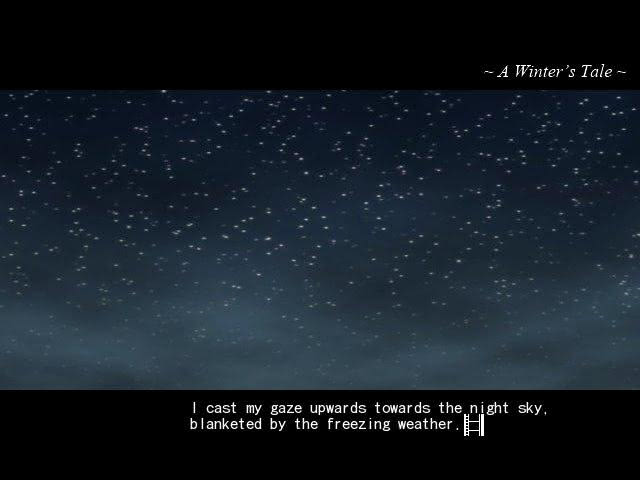
I like how A Winter’s Tale uses the letterboxing, and the movie aesthetic is buttressed by the cursor for advancing text being a roll of film. The style provides a nice frame for the visual aspect of the novel. It also makes the text very easy to read against a fully black background. Without spoiling, I will opine that the aesthetic has some thematic tie-ins later in the story.
My only complaint with the letterboxing effect is that this particular implementation severely limits the amount of text that can be on screen at one time, perhaps in part because the text begins closer to the center of the screen than the left-most margin. This led to a bit more pressing enter to advance the text than I would have liked.
The al|together 2005 festival page praised A Winters Tale for its backgrounds:
[T]he background pictures in particular are commendable…
I agree with this assessment. Excluding scenes with a fully black background, I counted 17 backgrounds, which is a large number given the game’s relatively short length. With the just a couple of photographic exceptions, the backgrounds are drawn and look quite good. See some examples below:

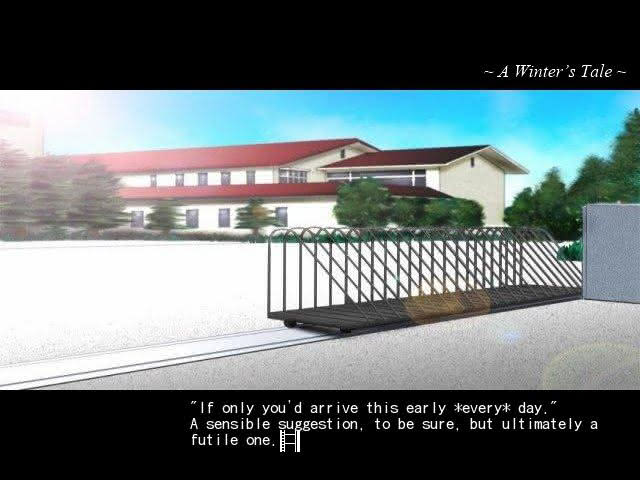
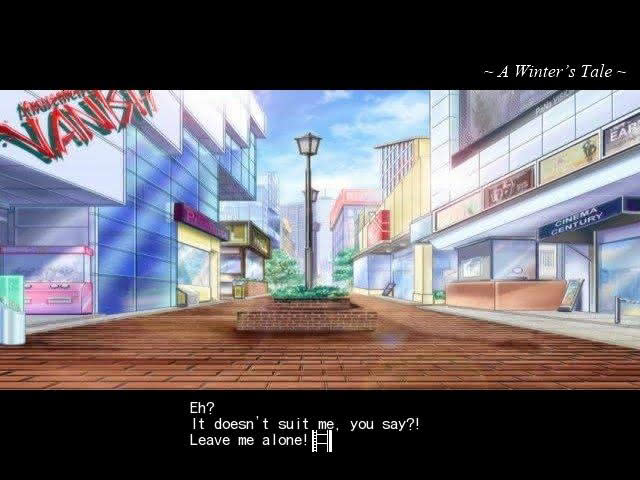
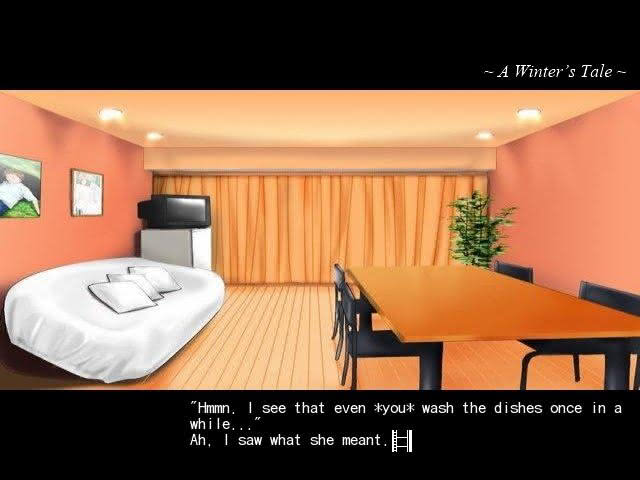
The variety in backgrounds allows A Winter’s Tale to meaningfully illustrate every in-game location and make it one of the better-looking games of the al|together collection. Moreover, they display good attention to detail. For example, you can see changes in Jun’s bedroom window depending on the time of day. The only background that I did not like was his kitchen.

For whatever reason, the kitchen in Jun’s ordinary house looks large enough to be of use to a small restaurant, and there is evidence in the story (as well as other backgrounds in Jun’s house) that would lead one to believe that Jun and his mother do not actually have a giant kitchen. However, in light of the fact that this was the only notable issue that I had with the backgrounds, my overall impression is highly positive.
Kaede is the only character who is depicted in the game. She has a full-body portrait with two outfits – one being her school uniform and the other being casual clothes. Kaede’s overall aesthetic has a distinct 1990s feel. Her pose never changes, but I counted her as having eight facial expressions as well as a small change in appearance in some of the later scenes.
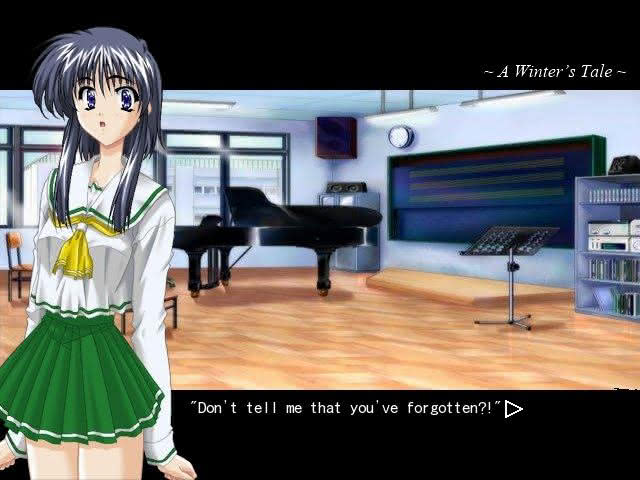
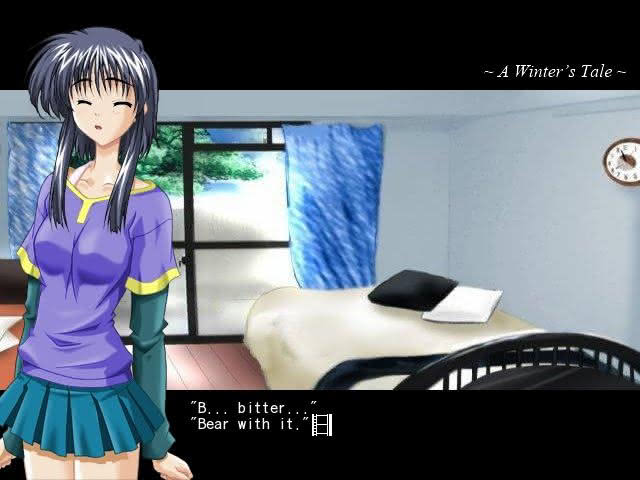

Kaede’s range of expressions are adequate, but she could have used an additional outfit (especially for a late-game scene) and a few different poses as well. Her character portrait is solid, but the lack of variety in poses and outfits leaves Kaede’s presentation a step below the backgrounds.
Before concluding, I must make note of the special shaking effects. There are a few occasions in the game where Kaede shakes Jun, usually when he has fallen asleep. When she does so, the whole screen shakes, including the game’s title in the top right, which I found this amusing – it is also the kind of attention to detail that adds a nice touch to this type of game. I finally conclude this section with A Winter’s Tale’s super-special effect:

Covering Jun’s eyes!
Music
The al|together review praised “the consistency of the music” of A Winter’s Tale’s soundtrack. Here too I largely concur. I did not count all of the background songs, but they sound good (in an unmistakably visual novel way), fit the game’s theme, and there are more than enough of them. Two of note were the song that plays early in the game when Jun and Kaede go to the arcade after school and the entire song that plays during a certain key event later in the game, and they are the musical stand-outs among the bunch. Unfortunately, there is no “jukebox” feature in the game’s menu to listen to the background music outside of playing the game. The end credits feature a song with vocals, which is very unusual for one of the al|together translations.
I did have one minor technical music issue. There were a couple of occasions when I left the game running when I got up to do something else. When I returned, the music had stopped (as in stopped looping), and it did not resume until I made it to a new scene. However, in most cases, the music did loop properly (and each track is long enough to not ordinarily need to loop often at regular reading speed), so I am not sure what caused the issue in limited cases.
Translation quality
I preface all of my translation notes by stating for the record that I am only assessing how the game reads in English. I not only do not know Japanese, but I do not have the Japanese version of A Winter’s Tale, Aru Fuyu no Monogatari.
While all of the al|together translations are very readable and many surpass a good number of commercial games, A Winter’s Tale is among the best in terms of how it well it reads in English. The dialogue is natural without exception, and I did not make notes of any notably clunky turns of phrase or instances where I was confused. One important point is that despite the fact that the text box in A Winter’s Tale does not list names with dialogue, it was never unclear to me whether Jun or Kaede was speaking. Unfortunately, we have no notes on the translation, but it is a terrific effort. The quality translation completed by AstCd2 should come as no surprise in light of the fact that he was behind unofficial translations of Kanon and Tsukihime, two much longer commercial visual novels.
Late in the game, there is a clear reference to a certain American movie that is significant to the overall plot of A Winter’s Tale. The movie is well-known enough that I suppose it is not impossible that the original Japanese game used the same reference, but if the original used a different movie and AstCd2 here substituted it for a reference familiar to English-speaking readers, he made a good choice and the dialogue explains the significance of the choice in a clear and concise way, which is something to praise regardless of whether the same movie appears in the original Japanese Aru Fuyu no Monogatari.
Writing and story quality
I begin with the al|together 2005 assessment of the story:
A charming piece built with well-loved, traditional ren’ai plot elements, then executed well enough to hold its own even given the fact that there’s only one heroine. … The characters are charmingly written enough, and the plot is pleasant if predictable.
I largely agree with the al|together assessment with a few additional notes and caveats.
The closest analogue to A Winter’s Tale among the al|together visual novels that I have reviewed thus far is At Summer’s End, a translation from the 2006 festival. That game, like A Winter’s Tale, featured two childhood friends adjusting to their changing feelings and sentiments, although the lead pair in that game was younger (middle school) than the duo in A Winter’s Tale. The plots and structures also share other notable similarities beyond the scope of this survey review. While I generally liked At Summer’s End, I described it as “thoroughly unambitious” – the same can be said for A Winter’s Tale.
A Winter’s Tale focuses exclusively on the interactions between Jun and Kaede and their changing feelings. With the main exception of a few lines of dialogue spoken by Jun’s mother and a couple of lines combined from a classmate of Jun and Kaede and one of their neighbors, the entirety of the game is either dialogue between Jun and Kaede and Jun’s internal monologues. Most of the dialogue is the ordinary banter of two long-time friends, but lurking within are their obviously growing feelings.
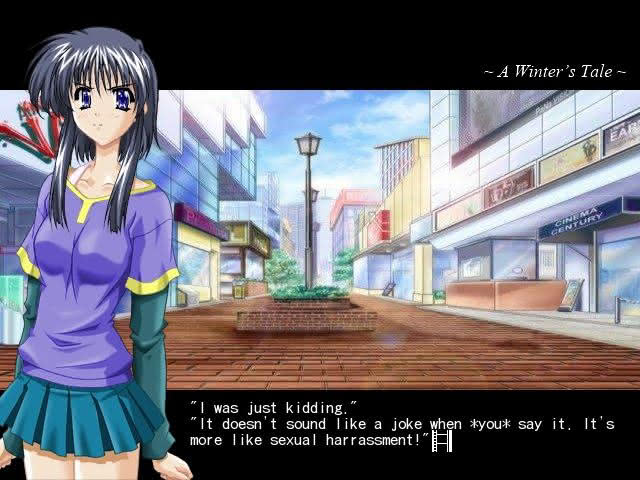
We see Kaede’s feelings through the eyes of the dense Jun (in his defense, he realizes that he is dense). Jun struggles to describe his own changing feelings in his internal monologues, which sometimes follow his blurting something out to Kaede.
The al|together 2005 review hit the right note in praising A Winter’s Tale’s execution. It is among the most tightly-written visual novels of the al|together collection, which is no small feat for a game in which most of the dialogue is friendly conversations. Little moments that the game makes a point of making note of come back later or provide insight into the main characters, especially Jun and his circumstances. Small turns of phrase from the characters reveal key points about them that are ultimately significant to the story’s conclusion. Scenes do not drag on for too long (contrary to At Summer’s End) and the game keeps a good pace throughout.
Readers’ mileage may vary regarding the character of Jun. He is, by his own admission, lazy and apathetic, and this can cause him to come off as unsympathetic. He is open to the fact that he does not understand a woman’s heart, and it shows in his inadvertently saying insensitive things to Kaede, an issue borne of his inability to see that her feelings for him may be changing just like his feelings are for her.

At the same time, Jun is astute in other ways – he knows Kaede very well as a friend, understands some things about her that would not be obvious to someone who does not know her, and shows that he can say the right things based on what he does understand. In short, Jun is very good at understanding Kaede in and of herself, but he struggles to understand her insofar as it concerns him.
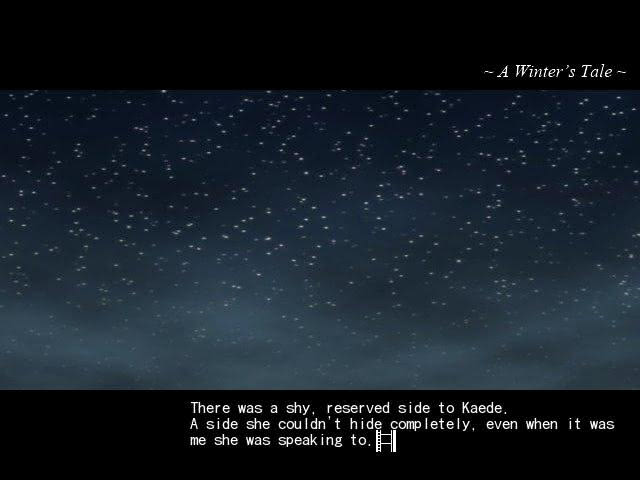
Jun is a decent guy on the whole, but his moments of denseness may be challenging for some readers – especially when the truth is obvious to third parties.
Kaede is very much an ordinary young woman who, much like Jun, is having to sort through some new feelings. While she gives as good as she gets with Jun, she is largely a more sympathetic character and, despite her own feelings, she is less prone to saying the wrong thing at the wrong time. As I noted above, it is a bit amusing that the reader’s understanding of Kaede is enhanced by Jun’s internal monologues in light of his struggles understanding Kaede in his denser moments. Kaede has some interesting contrasts in her character that manifest early. For example, in an early scene she almost forcibly drags Jun off to the local shopping area after school, preventing him from going home and taking a nap, but then reveals she had no plan for what she wanted to do – leaving it up to him when they arrived. Like many other subtle points in A Winter’s Story, this provides some hints about Kaede as a person.
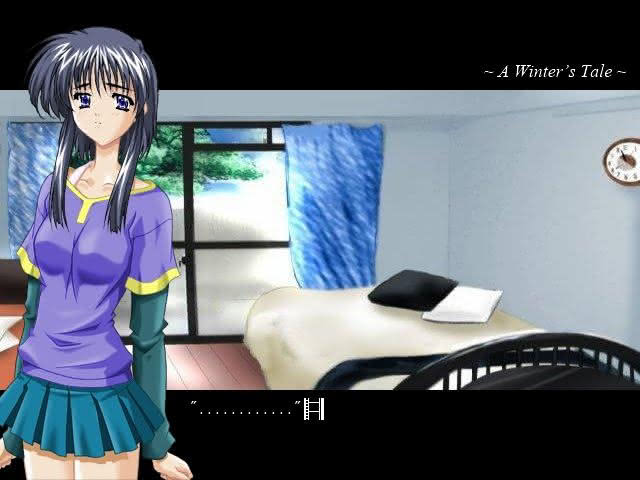
The overall plot was well-executed in showing the gradual progression of Jun’s and Kaede’s feelings over the course of a few days. The game’s narrow focus allowed it to concentrate its plot development, and as I noted, its pacing was very good. The single choice late in the game which slightly changes the ending was cleverly executed in a way that I did not expect when I first encountered it. Without spoiling, I will say that it very subtly (arguably too subtly) gives the reader the opportunity to choose how Jun approaches a particular issue. I had one minor qualm with one event late in the game which leaned too far into a trope that we also saw in At Summer’s End and another 2005 al|together entry, Plain Song. To A Winter’s Tale’s credit, howecer, it fully resolved the issue in the end and ultimately used it in an effective way to bring about the conclusion to the story.
Miscellaneous technical notes
A Winter’s Tale features an ordinary, but sparse, menu system with the expected save and text history functionality.
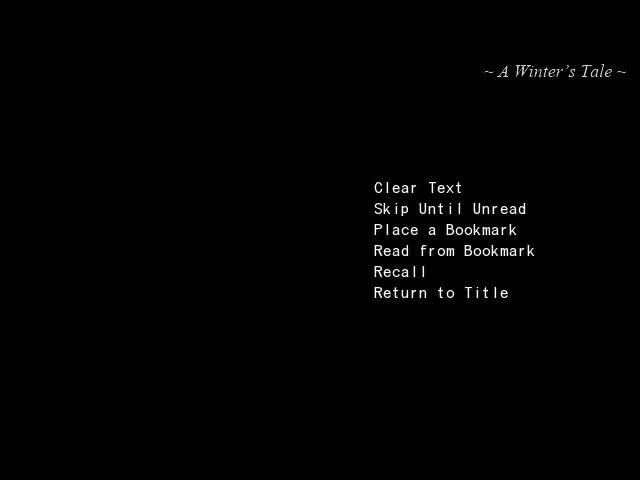
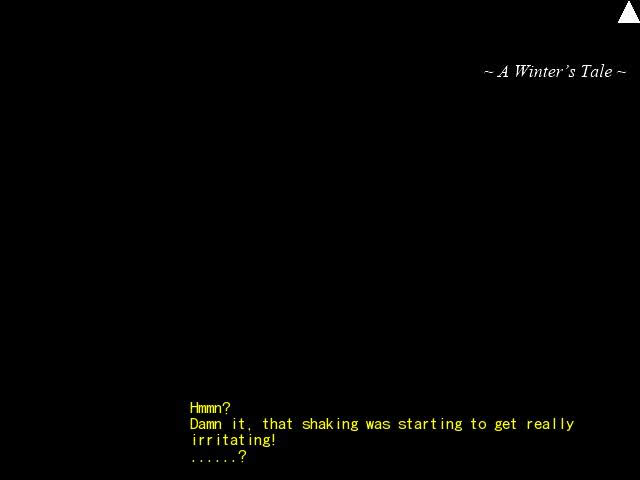
After completing the story once (it does not matter which ending the player receives), the player unlocks a short postscript, which is then added to the start menu along with a different Kaede portrait.
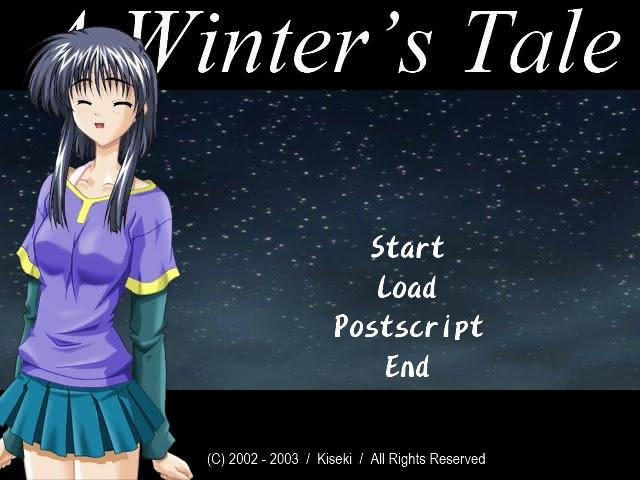
The postscript features notes from the director rather than additional story content. It was here I discovered that there were two versions of Aru Fuyu no Monogatari, and that At Winter’s End was translated from the second version. However, it sounds like very little was changed from the original 2002 release in Japan to the final 2003 version.
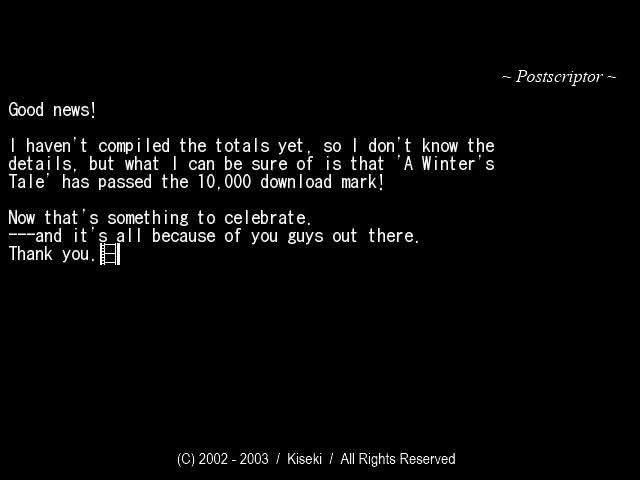
It would have been nice for there to be a jukebox feature given the game’s solid soundtrack, but the menu, like many elements of the UI, was more stylish than than of your typical freeware NSCripter project.
Conclusion
The al|together 2005 festival page for A Winter’s Tale described it as “one of the true anchor pieces for [the 2005] festival,” placing it alongside two visual novels that I have not yet reviewed on site (as of February 14, 2023). I concur that it is a fine piece, and it is among the more refined overall productions that I have reviewed thus far. The background art is solid, the music fits, and it is well-written, accomplishing all of its ends within its relatively short reading time.
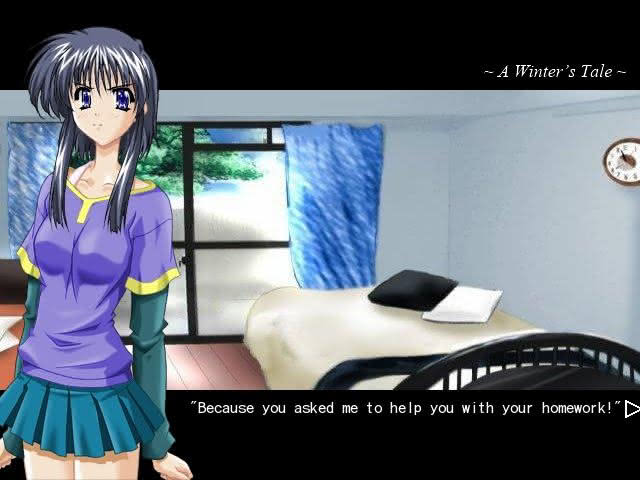
However, much like At Summer’s End, having a lack of ambition is a bit of a double-edged sword. A Winter’s Tale is solid, technically sound, and makes for pleasant enough read, but other than enjoying the story and noting its sound execution, there is less to say about it than is the case with some of the al|together productions with comparable high production values, such as May Sky and Shooting Star Hill.
I highly recommend A Winter’s Tale to fans of the genre or visual novel fans generally, both for its sound production values and for its value as a well-designed freeware piece of its era. As a general matter, this, like At Summer’s End, is a case where I would advise readers to consider whether my description of A Winter’s Tale’s themes sound interesting. While I refrained from spoiling its ultimate conclusion, my description is on point with respect to the content, and one’s enjoyment of the game will depend on whether you enjoy the relationship and interactions of Jun and Kaede.

February 16, 2023 update: See my follow-up article researching the version release history of Aru Fuyu no Monogatari.